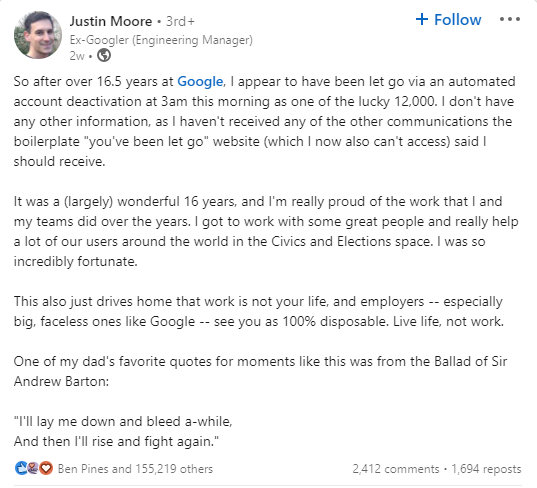Tech Layoffs 2023: Everything You Need To Know

In this article
In purely numerical terms, the mass layoffs in Big Tech in 2023 alone appear nothing short of apocalyptic. Amazon, Vimeo, and Salesforce were responsible for 25,000 job cuts in the first week of January. Google recently slashed its headcount by about 12,000, or 6% of its full-time workforce. These cuts applied to employees deemed as “not having enough impact,” per The Information, including managers receiving compensation packages of $500,000 to $1 million.
In the third week of January, Microsoft announced it would shed 10,000 staff members, representing the company’s roughest job cuts in eight years despite amounting to less than 5% of its workforce. Meanwhile, PayPal is in the process of laying off 2,000 employees, equivalent to 7% of its workforce.
To make a bad situation worse, some employers have normalized virtual layoffs—informing hundreds of unsuspecting employees on a Zoom call that their livelihood is compromised instead of in a one-on-one private conversation.
One former engineering manager at Google received no formal communication about his redundancy. “After over 16.5 years at Google, I appear to have been let go via an automated account deactivation at 3am this morning as one of the lucky 12,000,” he wrote in a LinkedIn post. Another ex-Googler was laid off while she was in labor.

The alarm raised by recent headlines makes it easy to forget that the current wave started last year. Tech layoffs in 2022 totaled an estimated 120,000. However, barely two months into 2023, 66,000 tech jobs have been cut.
For now, at least, the long-anticipated economic downturn isn’t here yet—overall unemployment remains low despite mass layoffs in the tech and mortgage industries—but companies are preemptively cutting costs in anticipation of a recession.
“Consumer purchasing and, more significantly for many internet companies, advertising spending typically falls during a recession,” said Josh Thill, founder of Thrive Engine. “With these challenges on the horizon, technology companies need to tighten their belts to make it through the uncertain time.”
Putting the layoffs in perspective
While the number of workers impacted by workforce reductions is shocking, Big Tech’s future is far from imperiled, and recent layoffs barely made a dent in the hiring frenzy that preceded it. While Cisco cut 5% of its workforce last year amid a $600 million restructuring plan, the company will “exit this fiscal year with more people than when we entered it—or close to the same amount,” CEO Chuck Robbins told Bloomberg.
When Alan Stein, founder and CEO of Kadima Careers, crunched the numbers on the recent layoffs from Amazon, Google, Meta, Microsoft, and Salesforce, he found that all five companies had a net addition to their headcount or a total of 123,145 more employees.
“These companies hired 182,000 people over the last year, then they laid off 59,000,” Stein said in an interview. “If you look at the net growth over the last year, they increased headcount by 5.8% and added a net of 123,000 people—that’s a lot of people.”
Why are the tech layoffs happening?
While most people are happy to forget 2020 ever happened, tech companies are still course-correcting as the pandemic’s effects ebb. During the lockdown, demand soared for e-commerce services, remote work infrastructure, streaming platforms, and other digital products—galvanizing a hiring frenzy. Zoom went from a relatively unknown video conferencing platform to an unofficial verb, like how someone might say, “Let’s Google that.” Meanwhile, Amazon’s net profits soared 84% in 2020.
“Companies overhired to meet demand—and they couldn’t hire cheap contract employees based in the Phillippines, India, or Buenos Aires or wherever because they were also under lockdown, so they just hired full-time employees,” says Stein.
As demand for digital products returns to pre-pandemic levels, companies scramble to rein in costs. On top of that, tech companies tend to limit R&D and innovation in a recession—which represents the majority of the job cuts in Big Tech.
“Many companies are shifting their focus away from certain areas, such as hardware and advertising, in favor of other areas like cloud computing and e-commerce,” said Yamini Rai, a career coach at Common Stupid Man. “This shift in priorities can result in layoffs for employees in the areas that are no longer a focus.”
To better understand what’s going on in Big Tech, here’s a look at the reasons behind some of the most high-profile layoffs of 2023:
Amazon struggled to monetize its hardware products
Amazon’s hardware teams working on Alexa, Kindle, and Halo teams were the first to be let go. The company hasn’t yet found a way to monetize voice queries on Amazon Alexa, and very few people use the voice assistant to make purchases on Amazon. The company’s business model for hardware products is to sell them at or near break-even, with the expectation that they serve as a gateway for purchases of other Amazon products such as audiobooks, Kindle ebooks, and, most importantly, items from Amazon.com. Workers in Amazon’s drone delivery unit were also affected.
Twitter reeling from its recent acquisition
Tesla founder Elon Musk’s drama-filled acquisition of Twitter led to mass layoffs and general upheaval. Twitter cut workers from its data science, machine learning, and engineering teams. Over 100 former Twitter employees have filed demands for arbitration or are participating in proposed class action lawsuits related to the layoffs. Musk, who has long claimed that Twitter’s algorithms exhibit “left-wing bias” disbanded the ethical AI team responsible for making the platform’s algorithms fair and transparent.
The company also axed its Trust and Safety Council and seemed prepared to relax content moderation standards. Twitter is struggling with the exit of many advertisers due to concerns over brand safety and content moderation, in addition to Musk’s “erratic behavior.” Advertiser groups such as IPG Mediabrands and Omnicom Media Group have advised brands to avoid Twitter. Ninety percent of Twitter’s revenue in 2022 came from advertising.
Microsoft is refocusing on AI over hardware

Microsoft is refocusing on AI after PC sales fell by more than 25% since pandemic highs, causing a drop in Microsoft’s share price (Dell recently announced a 5% workforce reduction for the same reason). The tech giant is pulling back after years of frenetic hiring to meet the pandemic-fueled surge in online services and the expansion of cloud computing. Microsoft’s revenue grew 58% over three years when it hired more than 75,000 people, but recently reported its slowest revenue growth in five years. Microsoft still plans to invest another $10 billion in OpenAI, the company responsible for ChatGPT, and proceed with a $69 billion acquisition of video game maker Activision.
Meta pulling back after overhiring during the pandemic
Under most circumstances, overhiring sets companies up for mass layoffs, especially when executives overestimate demand. Meta grew its headcount from 48,268 staffers in March 2020 to more than 87,000 as of September 2022. After laying off 11,000 workers in November, CEO Mark Zuckerberg wrote in a memo to employees, “I got this wrong, and I take responsibility for that.” Meta lost about $800 billion in stock value since its September 2021 peak (but it has since rebounded). “When companies lay off people, the stock market likes that, even though it’s not good for the employees,” said Stein.
Vimeo is shifting the focus of its core business
Vimeo has been shifting to big corporate clients like Gap, Nike, and Expedia and away from its role as a YouTube alternative. CEO Anjali Sud also cited an “uncertain economic environment” to explain the reduction. This after a 6% workforce reduction in July. The majority of layoffs were employees in the sales and R&D departments.
Will this happen again in the future?

By definition, a tech bubble occurs when investor overexcitement backfires. Eager to fund the next unicorn startup, investors pour money into high-growth tech companies—even those that aren’t yet profitable—thereby inflating stock valuations. At some point, the money pumped into the industry far exceeds the potential revenue return. This leads to an implosion—sort of like a bubble popping.
Airbnb, Reddit, and WeWork are worth billions despite not being profitable, which is not uncommon in tech. A Pitchbook report published in 2019 showed that of 100 startups worth more than $1 billion that completed an IPO since 2010, 64% were unprofitable. Tech companies typically plow profits back into the business for research and development or product innovations, so while investors don’t see immediate returns, they are willing to delay gratification in exchange for a future payout.
“Bubbles are inherent in society because people operate with a herd mentality,” said Stein.
Case in point: Amazon is the world’s second most valuable company by market capitalization, yet its profits are far less than Apple and Facebook. This leads to an industry where tech companies focus almost exclusively on investors, valuations, and the next fundable milestone. At the first sign of trouble, companies lay off their workers to brighten their balance sheets and reassure investors.
So why are tech companies overvalued right now? Historically, low interest rates throughout 2020 and 2021 made it easy for investors to plow money into tech for high returns. When the Federal Reserve raised interest rates in 2022 to counteract inflation, investors started selling their stocks, causing stock prices to drop and jeopardizing companies reliant on continuous funding. Consequently, “lockdown” stocks like Peloton and Zoom are trading at a fraction of their all-time highs. At one point, Apple and Amazon lost $180 billion and $130 billion, respectively, in stock value in one day.
However, Stein says that the workforce reductions in Big Tech are nothing like the dotcom bust of the late 90s when numerous internet startups failed.
“I think these Big Tech companies were just overvalued and grew too fast,” said Stein. “But there are no ramifications to these companies for cutting people. They’ve gotten some bad press, but they’ll get over it.”
Enterprise IT spending on cloud infrastructure and SaaS applications is forecast to grow over the next year as companies use tech to battle expected recession. However, these moves could backfire as companies find new ways to rely on automation and AI.
What’s next for laid-off tech workers?

For the last two years, tech workers fielded multiple offers, unheard-of starting salaries, and flexible work arrangements. They’ll lose some bargaining power as laid-off workers compete for the same jobs.
While risk-averse job-seekers may prefer to avoid Big Tech, FAANG companies are still hiring and typically offer superior compensation and working conditions over “traditional” industries—including flexible work arrangements, above-average employee benefits, and a company culture that encourages dissent.
“The median compensation at Google is $296,000 a year, and Google has about 150,000 employees right now,” says Stein. “To put that into perspective, nearly twice the number of people it would take to fill the MetLife Stadium make over $296,000 a year.”
Layoffs at tech companies create opportunities for non-tech companies that struggled to acquire talent over the last two years—think companies in retail, banking, insurance, healthcare, hospitality and travel, and management consulting.
These “traditional” firms are seeking talent with sought-after skills in AI, machine learning, automation, data science, and programming to modernize business processes, optimize the user experience, collect data-driven insights, improve supply chain management, and manage human resource planning. Laid-off workers may be looking for steadier employment opportunities—particularly those on H-1B visas who must find new employment within 60 days or leave the country.
Companies like Target, Nike, Home Depot, and Best Buy have undergone successful digital transformations in recent years. While they aren’t as objectively “sexy” as Big Tech, they have an equal need for tech talent to build and manage databases, update and maintain their web presence, and implement machine learning algorithms for business decision-making.
Even Big Tech companies are still hiring, although many have refocused on hiring contractors rather than full-time employees to keep their labor costs down, which creates opportunities for bootcamp grads.
“This puts Springboard students in a good spot because they can’t always get those top-of-the-line full-time jobs at FAANGs straight out of a bootcamp, but they can get a contract or entry-level role,” said Adenike Makinde, a career coach at Springboard.

Are tech workers able to find jobs elsewhere?
The good news is that the labor market remains tight, meaning most newly unemployed tech workers find jobs fast. About 79% of laid-off tech professionals landed a role within three months of starting their search, according to a ZipRecruiter survey of new hires. Nearly 40% find a new job within less than a month. With 10.3 million job openings, there are still more jobs than unemployed Americans.
Even so, optimism has plummeted. Just 9% of tech workers feel confident in their job security, according to a June survey from Blind, the anonymous professional networking site. In March 2022, 80% of tech workers were confident in the job market and considering looking for a new job.
Software developer job ads on Indeed are down 34% from a year earlier, and ads for mathematics roles—which include data scientists—are 28% lower. Overall postings are down 7.7% from a year ago.
Then again, “every company is a tech company, and they need programmers and data scientists and product folks to create digital products and services,” Ginny Cheng, a coach with Career Contessa, told CNBC. “There is security in tech roles.”
Tech companies offer generous severance packages, including healthcare coverage, job placement services, and immigration support for those affected. Google’s severance package starts at 16 weeks’ salary plus two weeks for every additional year at Google. Microsoft and Amazon offer full pay and benefits over a 60-day notice period, while Salesforce guarantees nearly 5 months of pay and “a minimum of two months of outplacement support.”
“I’ve been telling laid-off tech workers to cast a wider net; look at startups or consider going back to school,” said Stein. Those recently laid off from FAANGs may be hard-pressed to find similar compensation packages elsewhere, he adds. Still, employees with vested stock options can continue to earn income from stocks even after a redundancy.
Is any job secure?
Technically, no job is truly secure. The average employee tenure in tech is three years. This is partly because workers see the highest compensation gains when starting a new job, rather than being promoted internally. Another reason is the high-stress nature of tech jobs.
“Job security never existed because people are employed at will,” explains Stein. “Hopefully, this is a wake-up call to people to start owning their career and always be looking for their next opportunity.”
Having in-demand tech skills—data science, software engineering, UX design—makes you highly employable. Web developers were listed #2 in the U.S. News & World Report’s 20 Careers With the Most Job Security 2023. Projected employment growth is 30% from 2021 to 2031, which is much faster than the average for all professions, according to the US Bureau of Labor Statistics. Information security analysts also made the list, with employment growth projected at 34.7% over the next decade.
While job-hopping is generally frowned upon, the relative “normalization” of mass layoffs and the disappearance of job security have reduced the stigma of career breaks or leaving a role after less than a year.
“Before 2020, if you were out of the workforce for six months, people wanted to know how you could bounce back and add value to the organization,” says Makinde. “But with everything being online and people working remotely, it’s much easier to keep up your skills by taking online courses, and career breaks are no longer taboo.”
Remote work and freelancing also give workers more flexibility. If you’re concerned about putting all your eggs in one basket and finding yourself jobless during a recession, freelancing allows you to diversify your income and network with potential employers who may be hiring for full-time roles in the future. LinkedIn’s Workforce Report found that 20% of paid tech job listings on LinkedIn in October 2022 were aimed at contractors.
“Career-cushioning” has emerged as the latest buzzy workforce trend after “quiet quitting,” but Makinde advises getting into the habit of networking and even interviewing 2-3 times a year to explore what’s out there and keep one’s interview skills sharp.
“I think it’s a wise strategy—and it’s not the same as disengagement or not doing the work,” she says. “It’s more an attitude of “I’m going to put in my eight hours, but my time before and after is devoted to keeping my skills fresh, working a side hustle, or taking on a consulting role.’”

What can you do right now if you’ve been impacted by layoffs?
While layoffs are discouraging, they don’t signal the end of an exciting and lucrative career in tech. The outlook for high-growth technology positions is bright–eight of the top ten “best jobs” for 2023, according to Indeed, include roles like full stack engineer, data engineer, and machine learning engineer, among others. And while job cuts continue to impact big tech, these skills are still in high demand across other sectors like retail, finance, travel, government, health care, and more.
Springboard career coach Leanna Fredrich advises laid-off job-seekers to use their time to look inward and plan their next career move. “Try not to read the headlines about layoffs,” she says. Stay focused on your own journey, take your time to customize your resume to fit the positions you’re applying for, and network!”


